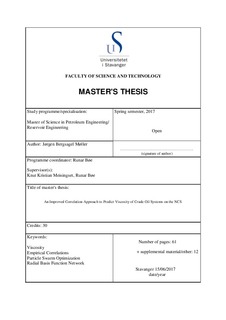| dc.contributor.advisor | Bøe, Runar | |
| dc.contributor.advisor | Meisingset, Knut Kristian | |
| dc.contributor.author | Møller, Jørgen Bergsagel | |
| dc.coverage.spatial | Norway | nb_NO |
| dc.date.accessioned | 2017-10-26T08:48:19Z | |
| dc.date.available | 2017-10-26T08:48:19Z | |
| dc.date.issued | 2017-06-14 | |
| dc.identifier.uri | http://hdl.handle.net/11250/2462291 | |
| dc.description | Master's thesis in Petroleum engineering | nb_NO |
| dc.description.abstract | An accurate estimation of viscosity values is imperative for an optimal production and transport design of hydrocarbon fluids. Based on this requirement, cost efficient and reliable empirical correlation models are highly profitable. While there are numerous correlation models from literature, a consistent correlation model is still needed, as most models are inadequate to predict an accurate oil viscosity using unbiased data. This study aims to develop new and improved empirical viscosity correlations through available field measurements on the NCS. The performance of the proposed models is then studied through a comparative analysis with published correlations from literature.
Three new correlations are developed for dead, gas saturated and undersaturated oils. The models are based on available field data from the NCS, where all PVT reports systematically were quality assured and controlled. A high-quality database is the single most important success criterion to develop an accurate and recognized prediction model. Two different correlation models are developed in this study using Particle Swarm Optimization (PSO) and Radial Basis Function Network (RBFN). The first technique is a computational optimization algorithm that improves a function with respect to a specified objective function, while the latter is an artificial neural network model that utilizes different radial basis functions as activation functions.
The optimization algorithm was used to re-calculate the coefficients of established viscosity correlations, while maintaining the functional pattern. The results show that the modified correlations are more in agreement with the test data for all three oil types, compared to the established correlations and RBFN, using the defined parameters from literature. The new correlations provide a mean absolute percentage error (MAPE) of 15.08%, 17.41% and 3.35%, for dead, saturated and undersaturated oil viscosity, respectively. However, the Kriging method proves higher accuracy than the modified saturated correlation, when including the saturated density as input parameter.
The RBFN demonstrates a secondary estimation performance compared to the modified correlations; nevertheless, the algorithm is considered to present a satisfactory low percentage error in dead and undersaturated oils, where the empirical response is superior to all discussed correlations from literature.
The results of this study make it reasonable to conclude that the proposed correlation methods are more in-line with the measured viscosity on the NCS, compared to the established correlation models that were analyzed. | nb_NO |
| dc.language.iso | eng | nb_NO |
| dc.publisher | University of Stavanger, Norway | nb_NO |
| dc.relation.ispartofseries | Masteroppgave/UIS-TN-IPT/2017; | |
| dc.rights | Navngivelse 4.0 Internasjonal | * |
| dc.rights.uri | http://creativecommons.org/licenses/by/4.0/deed.no | * |
| dc.subject | petroleumsteknologi | nb_NO |
| dc.subject | petroleum engineering | nb_NO |
| dc.subject | viscosity | nb_NO |
| dc.subject | empirical correlations | nb_NO |
| dc.subject | particle swarm optimization | nb_NO |
| dc.subject | radial basis function network | nb_NO |
| dc.subject | reservoarteknologi | nb_NO |
| dc.title | An Improved Correlation Approach to Predict Viscosity of Crude Oil Systems on the NCS | nb_NO |
| dc.type | Master thesis | nb_NO |
| dc.subject.nsi | VDP::Teknologi: 500::Berg‑ og petroleumsfag: 510::Petroleumsteknologi: 512 | nb_NO |

